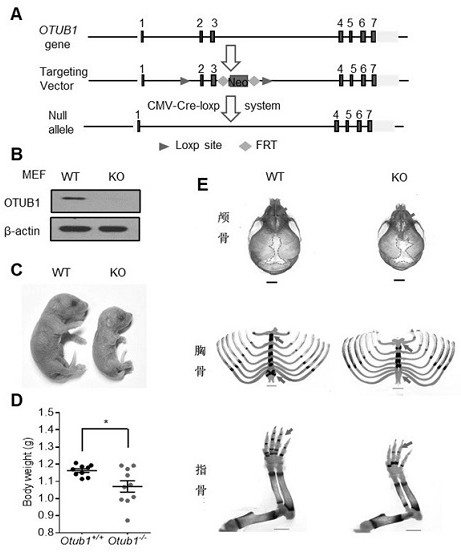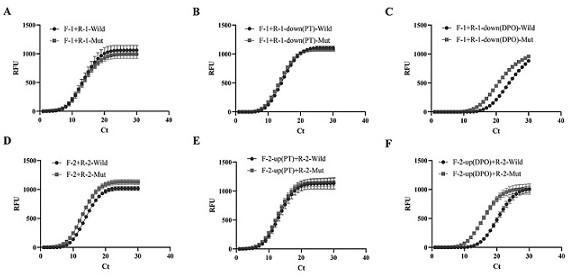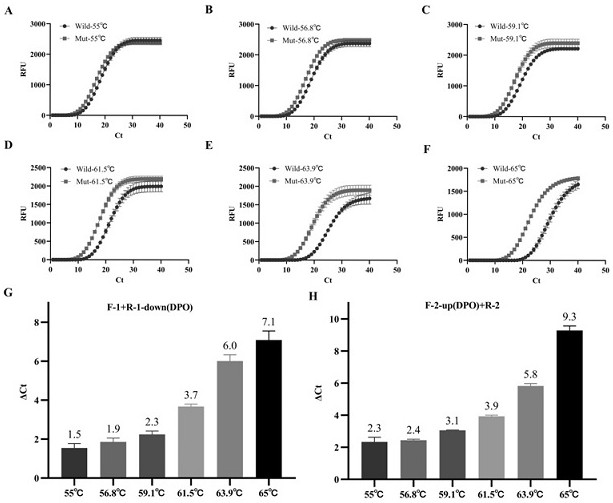SARS-CoV-2 delta variant detection method based on primer design and copper nanoclusters
A detection method, copper nano-cluster technology, applied in the field of biosensors, can solve problems such as complicated operation steps, and achieve the effect of increasing ΔCt value and high specificity
- Summary
- Abstract
- Description
- Claims
- Application Information
AI Technical Summary
Problems solved by technology
Method used
Image
Examples
Embodiment 1
[0049] Example 1. Design principles for the detection of SARS-CoV-2 delta variants based on rational primer design and copper nanoclusters
[0050] In order to more sensitively detect the variant strain of the new coronavirus, this study developed a precise detection method for the delta variant of SARS-CoV-2 based on primer design and CuNCs. The primer design includes two parts of PCR upstream primer and downstream primer. First, in order to improve the specificity of detection, DPO primers were used to identify the mutation sites, wherein the DPO primers were specific primers linked by polyisoxanthine, and the mutation sites with single base deletion were designed at the 3' end, and then passed Non-specific complementary hypoxanthine-linked primers with complementary bases at the 5' and 3' ends. At the same time, the AT base content of the primer was artificially increased at the 5' end, and the AT primer was constructed to increase the fluorescence value of CuNCs, making i...
Embodiment 2
[0054] Embodiment 2. Experimental feasibility verification
[0055] The method of PCR was used to prove the feasibility of DPO primers to distinguish the wild type and the delta mutant strains with single base deletion. A 25 μL PCR reaction system contains 1×SuperMix, 600 nM primers, and distilled water. The amplification program was 93°C for 3 min; 30 cycles of 95°C for 30 s, 65°C for 30 s, and 72°C for 30 s. Divided into 6 pairs of primers: F-1 and R-1, F-2 and R-2, F-1 and R-1-down (PT), F-2-up (PT) and R-2, F- 1 and R-1-down (DPO), F-2-up (DPO) and R-2. Among them, F-1 and R-1, F-2 and R-2 are common PCR primers designed by NCBI; F-1 and R-1-down (PT), F-2-up (PT) and R-2 It is a common primer, and the length of the primer is exactly the same as that of F-1 and R-1-down (DPO), F-2-up (DPO) and R-2, except that the middle part of the latter is a hypoxanthine link, while the former is linked with Targets are linked by bases that are perfectly complementary. The main dif...
Embodiment 3
[0056] Embodiment 3 Concrete experimental condition optimization
[0057] 1. Optimization of annealing temperature
[0058] Annealing temperature is the key factor to achieve specific detection, so in order to distinguish the above phenomena more clearly, two pairs of F-1 and R-1-down (DPO), F-2-up (DPO) and R-2 Primers were optimized for annealing temperature. The result is as image 3 , 3A-3F is the amplification curve optimized by the annealing temperature of F-1 and R-1-down (DPO), and it can be seen from the figure that as the temperature increases, the specificity of the detection method is better; Figure 4 Among them, 4A-4F are the amplification curves optimized by the annealing temperature of F-2-up (DPO) and R-2. It can be seen from the figure that the specificity of the detection method is better as the temperature increases; and image 3 3G and 3H in the middle show the change of the ΔCt value of the two pairs of primers with the change of temperature. Although...
PUM
 Login to View More
Login to View More Abstract
Description
Claims
Application Information
 Login to View More
Login to View More - R&D
- Intellectual Property
- Life Sciences
- Materials
- Tech Scout
- Unparalleled Data Quality
- Higher Quality Content
- 60% Fewer Hallucinations
Browse by: Latest US Patents, China's latest patents, Technical Efficacy Thesaurus, Application Domain, Technology Topic, Popular Technical Reports.
© 2025 PatSnap. All rights reserved.Legal|Privacy policy|Modern Slavery Act Transparency Statement|Sitemap|About US| Contact US: help@patsnap.com



